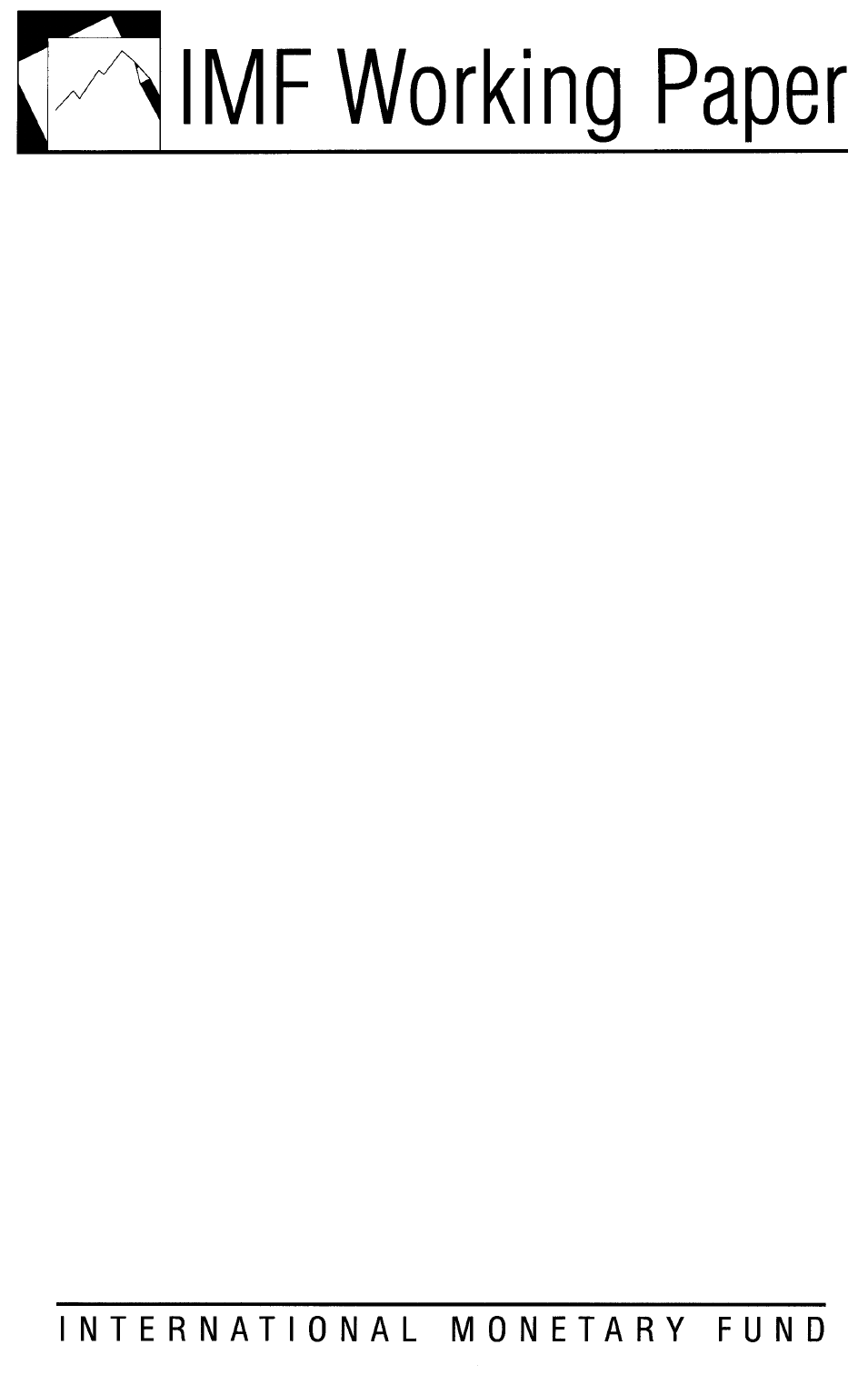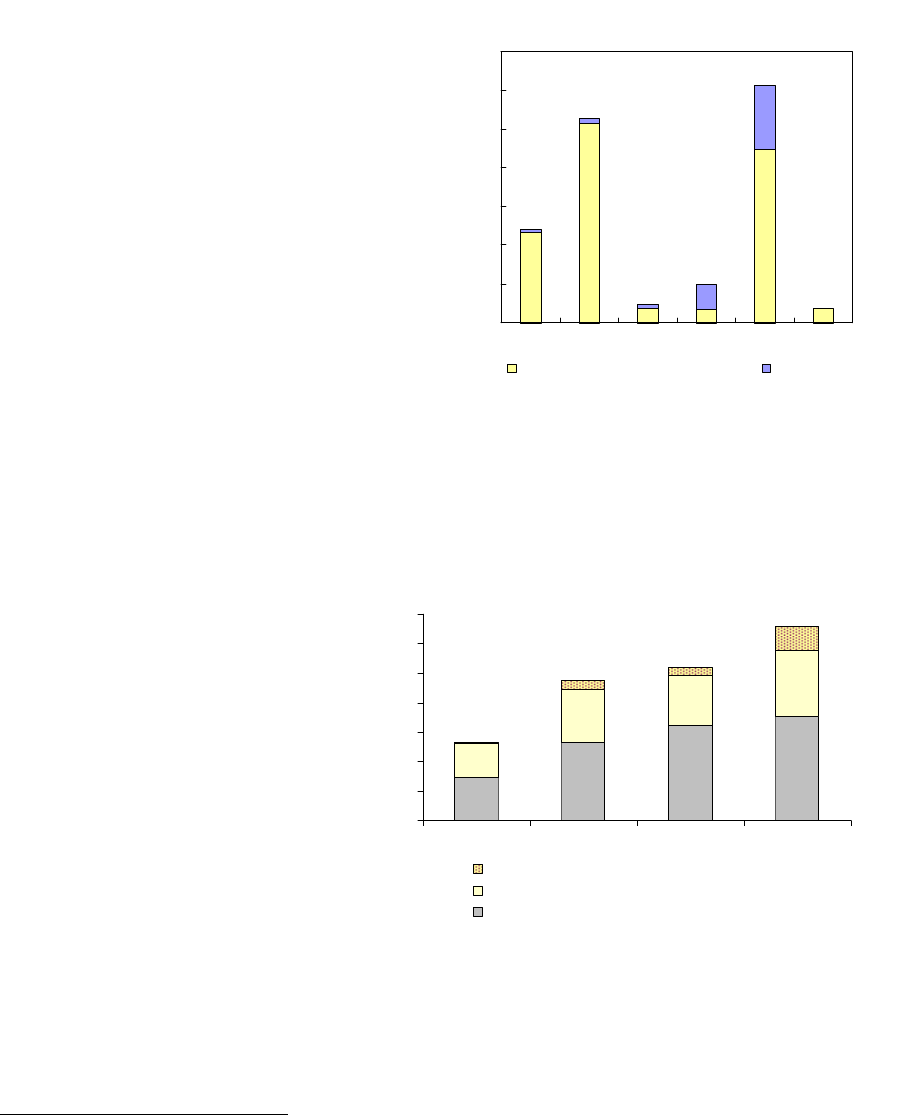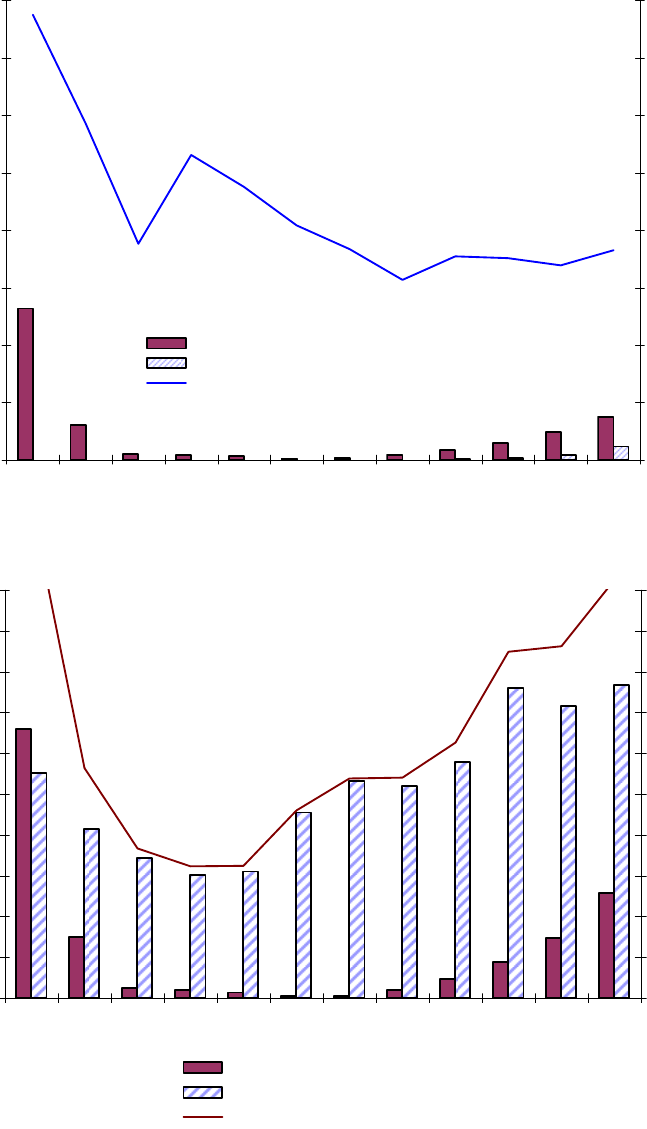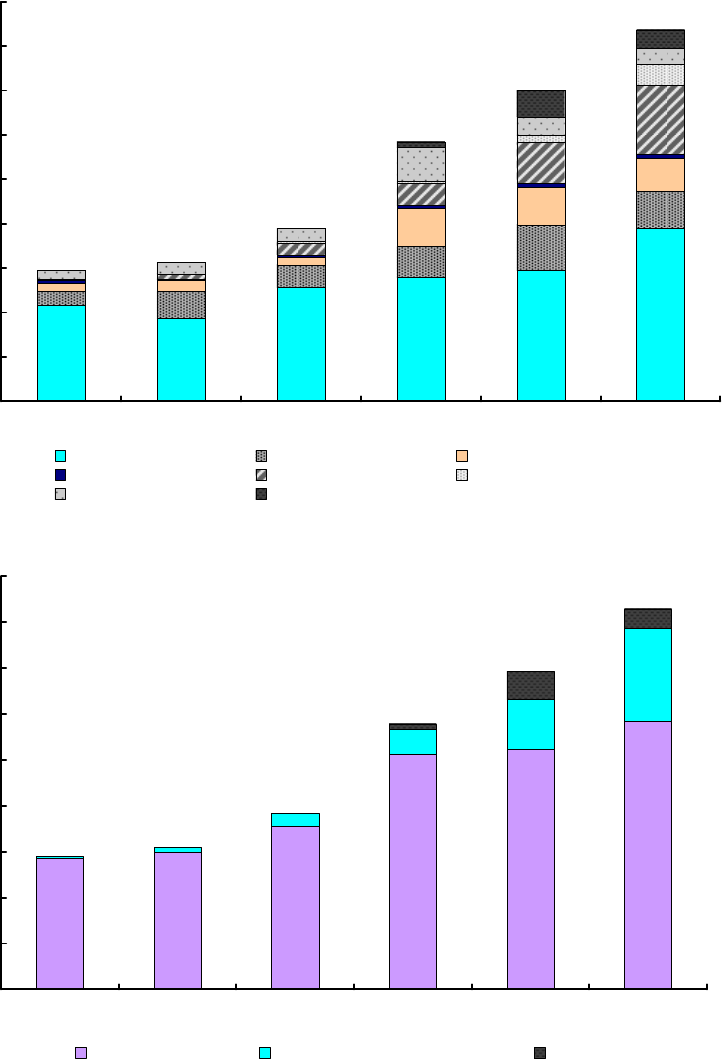
Housing Finance and Mortgage-Backed
Securities in Mexico
Luisa Zanforlin and Marco Espinosa
WP/08/105

© 2008 International Monetary Fund WP/08/105
IMF Working Paper
Monetary and Capital Markets Department
Housing Finance and Mortgage-Backed Securities
in Mexico
Prepared by
Luisa Zanforlin and Marco Espinosa
1
Authorized for distribution by David S. Hoelscher and Carlos I. Medeiros
April 2008
Abstract
This Working Paper should not be reported as representing the views of the IMF.
The views expressed in this Working Paper are those of the author(s) and do not necessarily represent
those of the IMF or IMF policy. Working Papers describe research in progress by the author(s) and are
published to elicit comments and to further debate.
This paper reviews the Mexican experience with the securitization of residential mortgages.
It highlights the key legislative and institutional reforms leading to the development of
primary and secondary mortgage markets and reports the main features and valuation
practices of the RMBS markets. The paper identifies areas warranting close attention to
improve the outlook for the Mexican RMBS market and draws some lessons from the recent
U.S. subprime mortgage market problems.
JEL Classification Numbers: O16; G21.
Keywords: Mexico; Housing Finance; Mortgage-Backed Securities; RMBS.
Author’s E-Mail Address: [email protected], [email protected]
1
The authors would like to thank David Hoelscher, Carlos Medeiros, Steve Phillips and David Robinson for
helpful comments and suggestions, to Graham Colin-Jones for helpful editorial comments and Claudia Pescetto
for her able research assistance. Special thanks to Alan Elizondo and Oscar Grajales Herce in Mexico’s
Sociedad Hipotecaria Federal for very informative and candid communications.
2
Contents
I. Introduction........................................................................................................................... 3
II. A Brief Review of Housing Finance in Mexico ................................................................... 3
III. Reforming Institutions: The Foundations for Private Mortgage Markets ............................6
IV. The Mexican Way: From FOVI to HiTo ............................................................................ 11
A. Securitization and Rise of the Mexican RMBS Market............................................... 14
V. Past lessons and Future Challenges .................................................................................... 20
Boxes
1. Brief Chronology of Important Events in the Housing Finance Sector................................ 5
2. Securitzation ......................................................................................................................... 8
3. SHF’s Guarantees Program................................................................................................. 13
4. Main Characteristics of Mexican MBS Issues.................................................................... 19
Figures
1. Latin American Local Issuance of Securitized Assets 2006............................................... 15
2. Mexico: Domestic Market Private Debt Issues by Structure.............................................. 15
3. Mexico: Historical Trends in Credit to Housing................................................................. 23
4. Mexico: Structure of Housing Finance, 2000–2005...........................................................24
References.................................................................................................................................... 25
3
I. INTRODUCTION
Widespread household access to home finance has long been a goal of governments in
Mexico. For generations, the Mexican approach focused primarily on redistributive schemes,
implemented through state-sponsored housing funds, which were notorious for their
inefficiency and poor governance. During the first part of the 1990s, the privatization of the
banking sector led to very rapid growth in mortgage loans, but the sharp increase in interest
rates following the1994 Tequila crisis contributed to record defaults and the near-collapse of
the banking sector, followed by a long period of lending retrenchment.
Current efforts to develop the mortgage markets are built on a more solid foundation.
Since 2001, the Mexican authorities have focused on developing the framework and
infrastructure to support primary and secondary mortgage markets; in contrast to previous
initiatives, the new approach places emphasis on market mechanisms, such as private
mortgage insurance, and improvements in housing repossession procedures and the property
registries. Both the primary and secondary mortgage markets have been developing in recent
years and remain a work in progress as the government continues to adapt best international
experiences to Mexican circumstances.
The paper tracks and highlights the key legislative and institutional reforms leading to
the development of primary and secondary mortgage markets in Mexico and reports
the main features and valuation practices of the RMBS markets. The paper identifies
areas warranting close attention to improve the outlook of the Mexican RMBS market and
draws lessons from recent developments in secondary mortgage markets. The remainder of
the paper is organized as follows. Section II traces the experiences of housing finance
mechanisms over the past three decades and the historical landmarks that led to the current
structure of the institutions providing housing finance in Mexico today. Section III reviews
the recent reforms in the institutional framework enabling new instruments for housing
finance to emerge and contrasts them with the experiences in other countries. Section IV
describes the roles and the functioning of the different institutions providing housing finance
and the recent developments in the local market for mortgage-backed securities. Section V
concludes by identifying possible developmental hurdles and providing policy
recommendations.
II. A
BRIEF REVIEW OF HOUSING FINANCE IN MEXICO
Over the years, government sponsored financing of low-income housing has been
channeled through multiple institutions (see also Box 1):
• In 1933, the development bank Banco de Obras Publicas (BANOBRAS) was created
to finance low-income housing.
• In 1954, Fideicomiso del Fondo Nacional de Habitaciones Populares (FONHAPO)
was created with a similar purpose.

4
• In 1963, a government trust fund Fondo de Operación y Financiamento Bancario de
la Vivienda (FOVI), operating within the central bank, was created to provide low
interest mortgages for low to moderate income households. FOVI was funded by the
central bank and the World Bank and operated as a second-tier bank, providing
funding and guarantees (up to 45 percent of loss-given default) to the banks extending
mortgages to targeted households and low-cost housing developers.
• In 1972, Instituto de Fondo Nacional de la Vivienda para los Trabajadores
(INFONAVIT) and Fondo de la Vivienda para los Trabajadores al Servicio del
Estado (FOVISSTE) were created as government-sponsored construction and housing
development funding agencies. They have been funded by a mandatory contribution
of 5 percent of gross wages. For decades they have been the workhorse of
government-sponsored low-income housing finance. Indeed, INFONAVIT still has a
large presence in the primary mortgage market—about half of the market (see below)
(Figure 1).
2
However, for years INFONAVIT was known for its lax collection
practices and poor governance.
Directed lending and interest rate caps were popular credit allocation tools deployed in
the late 1960s and 1970s as a means to secure private mortgages. Six percent of total
bank credit had to be directed to housing finance at fixed or capped nominal interest rates.
The oil shocks of the 1970s led to high inflation, negative real interest rates and large
portfolio losses for banks, contributing to the 1981 banking crisis. The banking sector was
nationalized in 1982 and the banking losses were absorbed by the government.
In the early 1980s, government securities crowded out private credit instruments,
including mortgages. During the high inflation period of the early 1980s, banks were
authorized to issue “dual index mortgages” (DIM)—which allowed negative amortization of
the inflation-induced erosion of purchasing power.
3
However, the 6 percent minimum credit
allocation to housing lending remained a binding constraint for banks which did not increase
credit to the sector. Government securities represented 70 percent of banks’ total assets.
The re-privatization of the banking sector in the early 1990s did not immediately
stimulate a private mortgage market. DIM mortgages faded away because of the
continuous erosion in households’ purchasing power, the consequent rapid increases in
outstanding loan balances and associated increases in banks’ credit and market risks.
2
The federal government contributes to INFONAVIT’s capital as stipulated in its charter (Ley del
INFONAVIT).
3
The payments on the DIMs were linked to the minimum wage index (VSM) and the difference between the
changes in the minimum wage index (VSM) and the consumer price index was tagged to the outstanding
principal (negative amortization).

5
Furthermore, the 1980s’ experience with mortgage defaults reinforced banks’ cautious
attitude towards the mortgage market.
By 1993, the introduction of legal reforms, inflation-indexed mortgages and benign
international liquidity conditions led to a rebirth of a private mortgage market. In 1992
legal reforms were introduced to modernize housing deeds. At the same time, the country
experienced a surge in capital inflows, stimulating a rapid growth in mortgage lending.
Between 1989 and 1994, total bank credit to the private sector increased from close to
13 percent of GDP to more than 50 percent of GDP, while bank mortgage lending jumped
from 1.3 percent of GDP to 2.4 percent of GDP (some 4.7 percent of total bank credit,
compared with 10 percent in 1989).
The sharp interest rate spike in the aftermath of the Tequila crisis triggered a wave of
bank mortgage defaults. The majority of mortgage lending in the early 1990s had
adjustable interest rates. After the crisis, interest rates climbed to 74 percent, leading to
massive defaults and a public sector bank bail-out. As part of a restructuring effort, mortgage
loans on banks’ balance sheets were registered in an alternative payment index, the UDI,
which was a unit of measure that averages inflation over the past 15 days. Outstanding
floating rate and dollar denominated loans were converted to long-term loans in UDIs that
carried a fixed real interest rate, while the inflation component was capitalized.
After the crisis, commercial banks relinquished almost entirely the origination of real
estate mortgages to non bank financial institutions and public sector entities. In 1994
non-bank financial intermediaries that specialized in real estate mortgages (Sofoles) were
created, with their core market consisting of low income households. As non-deposit taking
Box 1: Brief Chronology of Important Events in the Housing Finance Sector
1933 BANOBRAS was created as the first public housing institution.
1954 FONAHPO
1963 FOVI
1972 INFONAVIT and FOVISSTE created as government-sponsored private and public
(respectively) workers’ housing funds
1982 Nationalization of the banking system
1986 Institution of the DIM mortgages
1986 Institution of FOBAPROA (now Ipab), the deposit insurance scheme
1988 Deregulation of interest rates
1989 Re-privatization of the commercial banking system
1989 Abolishment of the quantitative lending requirements and of the interest rate controls.
1991/2 Re-privatization of the banking sector.
1992 Reforms in FOVI and INFONAVIT and the public housing subsidy system.
1994 Creation of SOFOLES non bank financial institutions licensed to lend to particular sectors
for specific types of activity.
2000 Amendments to the General Law on Securities and Credit.
2001 SHF commences operations.
2002 Law on Guaranteed Credit.
2003 First RMBS issued.

6
institutions, Sofoles’ main source of funding was FOVI, which also acted as their supervisor
and determined the underwriting and service requirements. Since the second half of the
1990s, Sofoles have become the main issuers of private mortgages. Efforts were also made to
step up and improve the efficiency of INFONAVIT’s activities, and as noted by Gwinner
(2006), INFONAVIT has substantially improved its management, operations, and corporate
governance.
4
Recently, it has also widened its cooperation with the private sector though the
program “Apoyo INFONAVIT.” The program allows its members to leverage their
INFONAVIT savings to obtain market-based mortgage finance. INFONAVIT also has
securitized portfolios, although the securitizations have been expensive, requiring 18–
23 percent subordination of the residual certificate for the senior certificates.
Traditionally, bank mortgage activity concentrated on the middle to upper income
segments. Lower income segments were considered high credit risk and banks were reluctant
to invest on origination platforms. However, Sofoles’ success in originating and servicing
low-to-middle income mortgages led some commercial banks to acquire some of the largest
Sofoles. New bank lending represented 7 percent of residential mortgages in 2005 compared
to only 0.2 percent in 2000.
III. REFORMING INSTITUTIONS: THE FOUNDATIONS FOR PRIVATE MORTGAGE MARKETS
A series of obstacles hindered the emergence of a primary private mortgage market
until the mid-1990s. These included directed lending practices, a lack of comprehensive
borrower credit history records that would allow the estimation of historical default
probabilities; and the absence of a framework for the sharing of available borrowers’ credit
information across banks. The only credit information sharing mechanism until the early
1990s was the public credit registry (SENICREB) operated by Bank of Mexico, but its use in
supporting credit decisions was limited. In addition, there was significant uncertainty and
lengthiness associated with the home repossession process. Foreclosures in Mexico could
take up to five months to be filed for and two years for a foreclosure sale to be ordered. Even
then, owners would not be liable for any remaining amount which would remain due in the
event the foreclosed property sold for less than the lien amount owed.
There were also significant obstacles to the development of a secondary mortgage
market through securitization (Box 2). As pointed out by, for example, Barry, Castaneda
and Lipscomb (1995), there was a lack of standardization in mortgage loans, with each
commercial bank offering its own lending terms, and making it impossible to pool them to be
securitized. Furthermore, there was no government agency or public institution in charge of
directing or overseeing loan standards. The lack of a comprehensive credit history created
difficulties in estimating not only default probabilities, but also pre-payment probabilities.
4
FOVISSSTE’s operational improvements, though not trivial, are much less significant than INFONAVIT’s.
7
Moreover, the legal framework for the sale of real estate assets necessary for a securitization
to take place was particularly cumbersome as, under Mexican law, the transfer of real estate
titles, such as mortgages, had to be registered with a central registry office, which was a
lengthy and costly process given the high fixed notary fees. In addition, by law, during a sale
of real estate assets, borrower notification was required, which tended to delay the process
significantly. Also, when a lien is registered on the property to secure a mortgage loan, such
lien did not give absolute seniority to the mortgage originator. In fact, the law specifically
identified categories of creditors whose claims will be considered senior to those of a
mortgage lender for the sale amount of a property. For example, municipalities have seniority
over other lenders for any tax amounts due and so do employees for any wages unpaid.
Finally, while real estate guarantee trusts existed prior to 2001 as legal entities that
functioned as a special purpose vehicle (SPVor SPE) in Mexico, their main objective was to
serve as a real estate trustee and were not allowed to issue debt (a key element for
securitization).

8
Box 2. Securitization
Main elements
Mortgage securitization is a technique which allows mortgage issuers to access fresh funding and to transfer market and credit risk imbedded
in their existing loans. In a securitization operation, a mortgage originator sells its loan portfolio to an independent special purpose company or
vehicle (SPE or SPV). The SPV’s funding comes from its issues of securities to capital market investors. The cash flow generated from the
interest and principal re-payment of the loans is used to service the securities backed by mortgages (mortgage-backed securities or MBSs), and
the mortgages act as their collateral.
There are a number of legal steps and infrastructure requirements for an efficient securitization of mortgages (see Lea et al. 2004). First, the
loans in the pool to be the securitized should have uniform characteristics, including terms of the loan, documentation, credit quality and
performance history. Second, mortgage foreclosure procedures, which ensure protection of creditor rights, must be relatively speedy and of
low cost to ensure high creditworthiness of the securities. In addition, mortgages must be fully transferable, as the SPV needs to acquire full
rights over the receivables from the loans and its claim on the collateral must be senior to any other claim. This is necessary to ensure that the
creditors of the originator’s bank will be voided from any claim on the collateral of the securitized loan in the event the originator were to
default. Also, the tax system must be designed to allow for the transfer of assets to be securitized without generating costs in the mere swap of
funds from the loan originator to the SPV issuer.
The SPV must be an entity of “high credit quality.” For example, in the U.S .SPVs must be capitalized, to ensure creditworthiness to the
securitized issues, and legal empowered to issue securities. These SPVs also perform a mortgage service, for which they are paid between 0.25
and 0.5 percent of the loan balance.
The pricing of MBSs should reflect the historical patterns of re-payments and defaults in the areas where the mortgage loans were originated.
Therefore, data on default rates and on pre-payment history (particularly in the absence of pre-payment penalty), are crucial for an accurate
pricing of the MBSs. In this respect, not only the collection of such data but also an agreement that financial institutions will share credit
information will be necessary for an MBS market to develop.
Main Benefits
By securitizing the mortgage loans, mortgage originators can book the proceeds from the sale of the mortgages immediately as cash. Thus, the
operation generates funding for new lending activities. By transforming the loans in securities that can be held in investors’ portfolios,
mortgage originators will also be able to access a broader pool of private sector savings. By removing the loans from the balance sheets,
mortgage originators will achieve a diversification of credit and market risk. In addition, remaining mis-match in assets and liabilities’s cash
flows and any credit risk will be removed from the mortgage originator and dispersed across market investors. Finally, the regulatory capital
requirements of the mortgage originators are typically reduced as the loans are taken off their balance sheet.
In addition, the securitized bonds backed by mortgage loans (MBSs) can be structured in different ways to either achieve a certain
diversification of risk or to cater to the investment base. The most commonly found securities which are backed by mortgage loans are so-
called pass-through securities or tranched issues.
Pass-through securities will present exactly the same characteristics as those of the underlying loans in terms of coupon, term, duration and
market risk. In particular they will also have the same pre-payment risk as the underlying loans and all market and credit risk will be passed on
to the investors.
Tranched issues are paid sequentially according to seniority in such a way that the higher tranches receive the flow of pre-payments first, and
thus have shorter duration and the lowest risk, with the lower tranches being redeemed only after the higher tranches have been redeemed in
full. This presents investors with choices on the expected duration or risk of the security to acquire. It is typical that MBSs will aim for an
investment grade rating so as to be marketed to institutional investors. Since mortgage originators may not have very high credit ratings,
mortgage securitization transactions typically require some
form of credit enhancement in order to achieve an investment grade rating
or, a rating higher than the originator bank. The enhancements can either be included in the structure of the securities, so that,
for example, the principal of the underlying pool of loans is greater than the principal value of the securities issued (over-
collaterization) or provided by a partial guarantee provided by a third party.

9
Financial Sector Reforms to Boost Private Mortgage Markets
Significant efforts have been made to overcome the obstacles to financial sector
development in general and housing finance in particular. A number of legislative and
regulatory efforts were directed to improve the ability of financial institutions to achieve
creditor information and to improve contract enforcement and creditor rights by clarifying
and streamlining foreclosures and repossession process while developing the legal
framework for guarantee trusts to be operational in the mortgage securitization process.
In the first place, the banking secrecy reform enabled banking institutions to share
information on customer credit operations, providing a strong impetus to the credit
reporting industry. A shakedown in the late 1990s of the few existing private credit bureaus
led to the emergence of one dominant entity (Buró de Crédito) that is owned by financial and
non-financial institutions. The enactment of a law in 2002 (amended in 2003) to regulate its
activities and protect privacy rights, resulted in more than 1,000 institutions feeding the
databases of Buró de Crédito with positive and negative information on more than 64 million
individual accounts and 4 million company accounts. Banks and other lenders can obtain
real-time data on customers that, in combination with their own proprietary information,
allow them to better differentiate borrower risk (calibration of scoring models) and expand
credit.
Subsequently, in 2000, a new Securities Law together with the Law on Guaranteed
Credit
5
allowed guarantee trusts (fideicomisos) to act as a full-fledged Special Purpose
Vehicle (SPV).
6
Creditors of trusts were granted rights over loan collateral with no
exclusion: this increased the legal protection of creditors’ rights over trusts with respect to,
for example, mortgages (which are junior to other categories of creditors). In addition,
foreclosure procedures were simplified in the case of trusts because the administrators of the
trusts (trustees) had the right to sell loan collateral in a public auction and without following
a judicial foreclosure process.
7
The new law also allowed financial institutions to both act as
trustees and to be beneficiaries of the trust, so that banks and non-banks (Sofoles) may hold
title to a property through a trust and, in the event that borrower fails to pay the credit, the
trustees can foreclose on the loan through out-of-court-procedures. Financial institutions
were also exempted from the registration requirements for the transfer of mortgage liens (if
they continue to service the credits), thus further streamlining the procedures for
5
Ley General de Títulos y Operaciones de Crédito.
6
In Mexican law, the trust (fideocommisso) is a contract by which a person assigns a property to a special
purpose, transfers the title of the property to a fiduciary institution to get the purpose done and appoints a
beneficiary of the trust to receive the benefits.
7
If there is no controversy in the process. If there is a controversy, then the trustees will have to undergo formal
judicial process.

10
securitization operations.
8
The new Securities law introduced a new market instrument, the
so-called “certificados bursatiles” or ceburs, which were by nature sufficiently flexible to
also be used as a vehicle for securitized issues. The law also streamlined the formalities for
the transfer of mortgage liens by exempting financial institutions from the registration
requirement as long as they continued to service the credits themselves.
In 2003, further legislation
9
established standard financial clauses for every mortgage
contract and required that loan information should appear in a standardized format so as to
allow comparison across different contracts. The law also provided that the mortgage
originator, in case of an anticipated total payment, would assign all the rights derived from
the credit to the payer. This feature introduces prepayment risk to the holders of mortgage-
backed securities just as in the U.S. case. (Caloca-Gonzalez 2006). The regulations for credit
bureau operations were also further revised to improve timeliness of data and increased depth
and quality of borrower information.
Mexico has drawn from the international experiences with secondary mortgage
markets
As in the U.S., the Mexican secondary market was launched with the support of
government sponsored initiatives. In the U.S., the secondary mortgage market developed
through government sponsored agencies. However, SHF departed from the U.S. scheme
where government sponsored agencies buy mortgages from loan originators who comply
with certain standards, pool them together and use them to back their issues of securities
which are serviced with the proceeds from the underlying mortgages. In Mexico, originators
have been issuing directly mortgage-backed securities in the market and benefiting from
credit enhancements provided by SHF in the form of financial guarantees to mortgage
originators meeting SHF’s origination standards.
As in the U.S., the use of credit enhancements by private mortgage issuers have been
used to boost the ratings of mortgage-backed securities beyond their originator’s rating.
Recently, in Mexico, as in the U.S., private credit enhancements have also been provided by
global companies such as MBIA, FIGC, AIG, Genworth and AMBAC.
Some features of the Danish model have also attracted significant attention in Mexico.
The most important feature of the Danish secondary mortgage market has been its high
liquidity. The mortgage bonds are highly liquid because the large pools of securitized loans
offer uniform characteristics such as coupon, rate of amortization, and loan to value ratios.
Liquidity is also supported by a market-making scheme where ten commercial banks trade all
8
If there is no controversy in the process. If there is a controversy, then the trustees will have to undergo formal
judicial process.
9
Ley de Transparencia y de Fomento a la Competencia del Crédito Garantizado (2002).

11
open-for-issuance mortgage bonds at a common price. Issuance and trading is done through
the Danish Central Depository Institution (VP) and the pass-through bonds have the same
characteristics of the underlying pool of mortgage loans (see Frankel et al.)
10
. The adoption of
VP’s technological platform in Mexico is expected to contribute to help liquidity and smooth
trading of the RMBS market. As in the U.S., mortgages in Denmark, and Mexico have a
penalty-free prepayment clause, subjecting the holder of the mortgage to prepayment risk.
However, in Denmark, unlike in the U.S., regulation requires a strict matching of cash flows
between the underlying loan and bond servicing flows. The result is that prepayment risk is
held by investors who, relative to the U.S. housing agencies, accept larger fluctuations in the
duration measures of their bond portfolios (see Frankel et al. ). As in the U.S., the Mexican
scheme has no provisions to fend against prepayment risk.
IV. THE MEXICAN WAY: FROM FOVI TO HITO
In 2001, Sociedad Hipotecaria Federal (SHF) was created with a view to developing the
secondary mortgage market. Originally, the SHF was seen as playing a role similar to that
of the Federal Housing Agencies (FHA) in the U.S., such as Fannie Mae and Ginnie Mae,
providing partial mortgage credit guarantees and acting as a second-tier bank for Sofoles.
11
However, the SHF was designed to gradually reduce its direct second-tier bank role, shifting
toward supporting financial institutions in issuing mortgage-backed securities (MBSs)
directly in the capital markets.
SHF began selling partial financial guarantees and mortgage insurance to Sofoles (Box
3). The main guarantee programs consisted in a partial financial guarantee (Garantia de Pago
Oportuno or GPO) which provides protection for timely payment of the obligation of the
MBSs, similar to a credit line; and a default payment guarantee (GPI) or mortgage
insurance
12
which pays the financial intermediary or the trust up to 35 percent
13
of the
10
However, in Denmark, the pre-payment risk is reduced by a feature of the mortgage loans whereby a
borrower can deliver a bond in lieu of the mortgage payment. This feature has the advantage that the purchase
of the bonds on the market by the borrower does not cause a pre-payment event. It also has the advantage that
when mortgage bonds are trading at a discount, the borrower can take advantage of such discount to repay his or
her mortgage. This also implies that mortgage investors benefit from early repayment of mortgage loans for
bonds trading below par (and thus can re-invest their proceeds at a higher interest). In addition, mortgages are
transferable among borrowers which makes pre-payment risk in Danish mortgage securities less exposed to
demographic factors than in the U.S. securities (Frankel et al. 2004). This feature of the Danish model is not
being adopted in Mexico.
11
Direct SHF financing of Sofoles is to be discontinued in 2009 and, by 2013, SHF is to be a self-sufficient agency.
The latest data available show that, as of the end of 2005, the agency held close to US$15 billion in direct home loans,
up from US$13 billion in 2002.
12
Mortgage Insurance is a mechanism to transfer the credit risk from mortgage loans to an insurance company
at relatively low down payments. In various countries, such as the U.S. Canada, Australia and Hong Kong, this
insurance has been successful in promoting a mortgage market with reduced down payment (For example,
mortgage insurance can be structured to reduce the expected value of the loss on the loan for the bank. For
(continued…)

12
outstanding balance of the mortgage loan, plus interest thereon, and unpaid service and
insurance fees, after a mortgage loan is delinquent for six consecutive months. Such
guarantees are designed to provide bond insurance to MBS investors.
14
SHF also offers a swap to meet the housing finance needs of low to medium-income
households. SHF sells a swap of UDI for minimum salary payments. This allows borrowers
to make payments in multiples of minimum salaries against UDI denominated mortgages.
The structure of the mortgage for the borrower is similar to that of earlier DIMs. In order to
hedge against losses in the event that UDIs rise above the minimum wage, SHF sells the long
VSM position to FOVI which, eventually, would be bearing such losses.
example: given a 5 percent down payment, and a 15 percent mortgage insurance, the bank has at-risk 80 percent
of value of the loan).
13
Initially it was 25 percent and it was increased in April 2004.
14
The program of partial financial guarantees, which are paid for by the securitizing agents, relieves the market
from the liquidity risk associated with shortfalls in principal and interest. The mortgage insurance guarantee
provides a “first loss” position with respect to losses due to default of the underlying loans. Since the presence
of the guarantees lowers the probability of a principal loss for the investor and ensures the timely payment of
bonds until foreclosure, such guarantees effectively increase the credit quality of securitized loans. Through
financial guarantees, the credit quality of securitized loans can well exceed the credit quality of the originating
institution. Effectively, the guarantee scheme is supporting increased securitization activity by originating
institutions as they can sell the high-quality part of the credit to the market while not increasing their own
exposure to household sector risks.

13
The criteria set by SHF to condition the sale of GPI or GPO have the important effect
of inducing standardization in mortgage products. In particular, mortgages have to meet
Box 3. SHF’s Guarantees Program
Different kinds of guarantee programs are directed both to mortgage borrowers and to lenders
seeking to securitize mortgage portfolios. In general, SHF sets specific criteria to qualify for such
guarantees.
Guarantees for mortgage borrowers
• A swap of UDI for minimum salary payments (VSM). This swap allows borrowers in
UDI-denominated loans to reduce the risk of mortgage debt by transforming payments in
multiples of minimum salaries. The structure of the mortgage for the borrower is similar
to that of a loan in UDIs. However, the risk that an increase in UDIs is higher than the
increase in the minimum wage is taken over by SHF upon payment of a fee.
Guarantees for lenders
• A default payment guarantee (GPI) or mortgage insurance
1
will pay to the relevant
financial intermediary or the trust up to 35 percent
1
of the outstanding balance of the
mortgage loan, plus interest thereon, and for unpaid service and insurance fees, after a
mortgage loan is delinquent for six consecutive months and foreclosure takes place. The
fee for the GPI is paid for by the borrower, through the financial intermediary.
• A mortgage insurance scheme (GI) which insures the lender for up to 70 percent of the
outstanding balance of the mortgage loan, plus interest thereon, and for unpaid service and
insurance fees for certain loans, including those that contain an up-front subsidy from the
government.
Financial Guarantees for RMBS issuers
• A timely payment partial guarantee program, Garantia de Pago Oportuno (GPO), is
designed to provide assurance of timely payment of principal and interest up to 85 percent
of the outstanding balance of principal and interest for those loan portfolios that comply
with certain requirements. (However, the maximum protection acquired by any institution
has been 25 percent so far.) Timely payment guarantee is a credit enhancement at the deal
level of the structure, and is similar to a credit line. If the trust does not have sufficient
cash to make a given payment, the line of credit can be drawn to pay both interest and
principal. Once the line of credit is repaid, it can be drawn down again, if the need arises.
The fee to the provider of the GPO is part of the expenses of the trust.
To qualify for SHF’s support, mortgages have to be originated and underwritten following
specific requirements–among others, debt-to-income ratios, loan-to-value ratios, property type and
values, and reporting requirements for the financial intermediaries. Should a loan not comply with
the eligibility criteria, the trust would have to reimburse SHF for any payment made under the
guarantee for that specific loan.

14
debt specific income ratios, loan to value ratios, property type and values, and reporting
requirements for the financial intermediaries. In addition, SHF reviews all the loans to be
securitized before awarding GPO guarantees.
While initially SHF was the only provider of mortgage insurance and financial
guarantees, recently private sector financial guarantee providers have entered the
market. Regulatory changes in the insurance sector passed in 2006 led to the licensing of
two foreign mortgage insurance companies to operate in Mexico. Financial guarantee
providers such as Ambac, Genworth FMO, IFC and most recently MBIA, have been recently
competing with SHF in the provision of these guarantees.
Future plans of SHF include the development of a comprehensive mortgage data base.
SHF will oversee Mortgage Information Statistics (FIEH), which is designed to include
borrower characteristics, house prices and loan payment history. All such information will
become available to mortgage lenders, insurers and investors in securitized loan pools and
will provide an essential tool to enhance transparency and efficiency in the mortgage
markets. However, this project was not fully operative at the time of this paper was written.
Recently, Hipotecaria Total (HiTo) was set up with the goal of expediting the
securitization process. Although mortgage securitizations can be carried out through a
Trust, the process can take up to a month. In an effort to expedite the process, the Danish
central depository institution (VP), in collaboration with SHF, set up a technological platform
in HiTo to launch a system that is open to any party interested in the securitization of a
mortgage portfolio. HiTo allows the continuous interface of banks, Sofoles and the Mexican
depository institution INDEVAL so as to expedite and reduce risks in the securitization
process.
A. Securitization and Rise of the Mexican RMBS Market
The structured finance market has experienced extraordinary growth since its
inception both in asset types and debt structures. Total issues of structured securities
reached over US$6 billion in 2006—tripling in volume since 2004.
15
Mexico has the largest
issuance volume in Latin America. Early structured issues comprised primarily bridge loans
for construction to developers; federal tax participation revenues (transfers from the federal
government to states and municipalities); toll road receivables and consumer credit flows.
15
Data according to Fitch. There were two operations in 2004 and 2005 identical in nature for US$4.5 billion
and US$2.4 billion by Banamex and Banorte, respectively. However, the two operations, which concerned the
securitization of a loan by IPAB (the deposit insurance agency), were only possible because of a legal loophole
in the terms of the original loans which is not present in other loans by IPAB. Therefore, similar operations
cannot be repeated, and therefore, excluded from the total for comparison purposes.

15
Mortgage backed securities (MBS) based on residential mortgage loans (RMBS) made
their first appearance in late 2003
and by 2006 they had become the
largest structured asset class,
representing over 25 percent of total
local structured issues.
16
As of October
2007 there were over US$6.4 billion
RMBS issues outstanding in the
Mexican bond market by seven
different Sofoles, two banks and
INFONAVIT.
Favorable global liquidity conditions
and a growing local institutional
investor base have supported the
new structured issues. Securitized
structures are particularly attractive to pension fund managers because they typically carry a
high credit rating and long duration which matches well with their natural liability structure
and prudential regulatory
regulations.
The strong growth in RMBSs
was supported by SHF. Those
RMBSs that satisfy the loan
origination criteria, which would
make them eligible for SHF
support through credit
enhancements, are commonly
referred to as Borhis
17
in the local
market. However there are also
other types of mortgage-backed
securities outstanding. In the case
of Borhis, SHF offers support to
the liquidity of the issues by acting as “market maker” and thus committing to buy Borhis
both in the primary and secondary markets. Under normal conditions, SHF buys at a price
based on its own cash flow and computed according to a methodology based on certain
prepayment and default assumptions.
16
Data by Fitch.
17
Bonos Respaldados por Hipotecas.
Figure 2. Mexico: Domestic Market Private Debt Issues
by Structure
0
2000
4000
6000
8000
10000
12000
14000
2003 2004 2005 2006
MBS
Structured Securities (non-MBS)
Domestic Debt Securities (non structured)
Figure 1. Latin America Local Issuance of Securitized Assets
2006
0
1000
2000
3000
4000
5000
6000
7000
Argentina Brazil Chile Colombia Mexico Peru
In Million US dollar
s
Structured Finance Issues (non- RMBS) RMBS
Source: Fitch.

16
More recently, Mexico has adopted the Danish technological platform which enabled
mortgage originators to start issuing RMBSs closer to the Danish ones. The important
difference between these RMBSs and those previously in the Mexican market is that the
existing series can be augmented by re-opening it during the first year up to a pre-established
maximum and increasing the size of each issue in the market, thereby allowing it to achieve
higher liquidity.
18
A loan’s monthly payments will cause some bonds to be withdrawn from
the pool in the amount the loan pays down. These pass-through securities will be issued
through the centralized agency, HiTo. The first re-openable MBSs, so-called “Borhis
fungibles”, made their appearance in late 2006.
Issuers and Investors
Sofoles were the first and by far the most active users of the new financial instruments,
but INFONAVIT has quickly followed. As of October 2007, Sofoles accounted for
60 percent of total outstanding RMBS stock of issuances, while commercial banks
represented around 5 percent of issues. This has been due, in part, to the structural decline in
Sofoles’ funding sources, together with the rising demand for housing credit, which gave
strong incentives to Sofoles to securitize their portfolios. Following the success of the initial
RMBS structures, INFONAVIT rapidly became one of the largest issuers in the market, and
in October 2007 accounted for around 27 percent of the outstanding stock of RMBS issues in
the market. Commercial banks’ large deposit base had so far been sufficient to finance
lending activities. However, in the course of late 2006 and early 2007 several banks entered
the market and opened some of the largest issues outstanding (Box 5).
Local institutional investors dominate the market for structured issues. To date, the bulk
of RMBS issues are held by domestic pension funds and insurance companies. As tranched
issues appeared, institutional investor interest concentrated in the senior tranches. This strong
demand reflects a number of factors:
• First, Mexican MBSs are typically denominated in UDIs
19
and thus generate inflation-
linked returns matching pension funds’ liability structures (Box 5);
18
Every fungible Bori structure has reopening periods ranging from one to three years.
19
The UDI is a unit of account the value of which is updated daily and reflects the changes in the consumer
price index. On the 10 and the 26 of each month the Bank of Mexico publishes the UDI’s value for the next
fifteen days. On the 10 and the 26
th
day of the month the change in UDI value will be equal to the change in the
consumer price index in the previous 15 days of the month, the value for the days between the 10 and 26
th
will
be computed by distributing the total increase in the CPI across the number of days in the period. The UDI had
a value of 1 on April 4, 1995 (as of 4/2007 approximately 3.85).

17
• Second, by enhancing the credit profiles through financial guarantees, over-
collateralization, and junior tranches, structured issues achieve an investment grade
credit rating that local issuers would otherwise not achieve;
• Third, structured issues carry slightly higher yields than the comparable government
securities; and
• Finally, the terms of the underlying loans, together with those of the securing
collateral, allow structured issues to have a relatively long duration with respect to
other instruments in the local market, which tend to be concentrated on the short-end
of the yield curve.
Subordinated tranches of MBS issues reportedly have had less appeal, but appetite for
such tranches appears to have been growing recently. More recently, high liquidity in
international markets generated some foreign investor interest for MBSs as securities with a
relatively higher yield. Local mutual funds have also been attracted to them because of the
yield pick-up they offer. However, in some cases, junior tranches have been reportedly
retained by the originating institutions, thus preventing them from fully divesting their credit
risk.
Valuation and Rating
In Mexico, there is a high degree of uncertainty surrounding the parameters used to
model the cash flows from the RMBSs’ underlying assets. In particular, there is a lack of
comprehensive historical data on default rates, prepayment rates, and recovery rates and on
the length of the foreclosure process. In addition, recent legislative reforms affecting the
foreclosure process (as discussed above) may have altered the significance of the available
historical information, so that most of the relevant parameters in the valuation process have
to be assumed.
20
The lack of historical and market data housing prices further complicates assessment of
loan-to-value ratios and of the over-collateralization of portfolios. In principle, house
values for mortgages in portfolios guaranteed by SHF must be formally appraised; however,
most of the time, house prices for loan purposes have been supplied directly by the
construction companies. The authorities are also aware of the need to deter fraudulent
appraisals as these would compromise the valuation of RMBS, and the integrity of the
investors’ (e.g. pension funds’) portfolios.
20
For example, repayments rates are typically assumed to be constant, imputed either to the loan pool or to each
single loan. While in Mexico typically there are no restrictions or penalties on prepayments, the cost of
re-financing mortgages is high, thus prepayment rates have tended to be less sensitive to interest rates than in
the U.S. Market reports suggest the constant pre-payment rate has been assumed at 5 percent, and indeed
according to an SHF White Paper, historical experience with prepayments has been around this level.

18
The government bonds denominated in UDIs (Udibonos) used as benchmark bonds for
the pricing of the securities have been illiquid, complicating the price discovery process
for the securities valuation in the RMBS market. These bonds were the only local UDI-
denominated securities with a term structure relevant to RMBSs. However, historically, the
Udibono market usually has been very illiquid (it is heavily influenced by pension funds that
do not trade Udibonos actively).
Currently, the only source of information for RMBS prices in the secondary market are
the local price vendors.
21
The models used by these agencies to price the securities are not
fully clear; however, SHF is working with the price vendors to improve practices. SHF is not
required to buy the bonds at the prices announced by the vendors.
The valuation of RMBSs relies heavily on rating agencies’ review process. High ratings
make securities suitable for pension fund portfolios. Factors behind the high rating of the
early Borhis, beyond SHF’s partial financial guarantee, include SHF’s incentives to Sofoles
to issue loans with conservative loan-to-value ratios, mortgage insurance, and the UDI -VSM
swap for all UDI-denominated loans. In more recent issues, since the junior tranches
22
effectively provide an additional buffer for the senior tranches, the senior tranches have not
needed a financial guarantee to attain an “AAA” rating on the local Mexican scale. Some
issues which had a senior tranche with a total financial guarantee were rated “AAA” on the
global ratings scale. Because the mortgages in most securitizations are covered by mortgage
insurance for up to 35 percent of the losses, even the junior tranches still qualified for an “A”
rating.
23
However, for the initial rating of the securities, rating agencies have tended to rely
heavily on SHF’s due diligence on the quality of the loan portfolio to be securitized.
Furthermore, some have suggested that rating agencies should play a more proactive role in
the rating review of RMBSs, as there are reports that downgrades to RMBSs occurred only
after irregularities had become readily apparent.
21
Price vendors are institutions created in Mexico because of the structural illiquidity of the private issues
market. Such institutions are supposed to be independent and to provide price information for market operators.
22
Junior tranches are also referred to as “mezzanines.”
23
Local scale A is equivalent to BB- on the international scale.

19
Box 4. Main Characteristics of Mexican MBS Issues
The main features of the MBSs in the market have reflected, to a large extent, the type of originating
institution. MBS issues by Sofoles are typically denominated in UDIs and thereby are inflation-linked. The
underlying loans are mostly standardized, and carry enhancements purchased through SHF or other insurers (see
below). Issues originated by Infonavit
1
tend to have underlying loans more diverse in nature, although, reportedly, all
sharing the same duration of the structured paper that was issued. Typically the characteristics of INFONAVIT’s loans
depend on the borrowers’ income level and the size of the house to be purchased.
1
These issues carry no direct
financial guarantees but include over-collateralization as a form of credit enhancement. Because INFONAVIT is a
government-sponsored institution, there is a perception on the part of investors that these products also have an
implicit government guarantee. Diversified MBS issues by commercial banks have emerged at a fast pace. Such issues
are mostly structured to reflect the fixed peso characteristics of the mortgages extended by banks. Interestingly, not all
of these RMBs carry mortgage insurance and guarantees offered by SHF. Instead, the enhancements in a number of
commercial bank issues consist of extended liquidity facilities (or total financial guarantees) by large international
insurance institutions and tranched structures to support the credit ratings.
Coupon: Interest rates on MBS issues have averaged between 5 to 6 percent in real terms. More recent issues have
carried lower coupons reflecting both an easing of real rates in the economy and a compression in MBS spread vis-à-
vis their benchmark UDIbono bonds. While early issues carried a significantly higher spread (around 120–140 basis
points) with respect to the UDIbono yield curve, the more recent ones which ranged around 80–90 basis points. Over
time the spreads for Sofoles-issued MBSs have been compressed owing to the greater demand and higher liquidity of
the market provided by SHF’s activity on the secondary market. However, the compression in spreads also reflected
changes in the structure of the RMBS, in particular, the increased use of mezzanine tranches as the market developed
(see below). More recent issues have also benefited from a total financial guarantee (rather than just the partial GPO
guarantee) on the senior notes which brought a further decline in issuance spreads to around 40–50 basis points above
the UDIbono benchmark.
Term : RMBS term has ranged from 10 to 30 years with most of the most recent issues around 30 years. They carry
the longest maturities available for a private (and public) sector security on the market. The typical term for other
types of asset-backed issues in Mexico has been from five to seven years.
Credit Enhancements: Most of the issues by Sofoles are structured so as to comply with requirements to qualify for
the SHF partial financial guarantee (GPO). The qualification requirements for GPO are that the holders underlying
mortgages need to hold a UDIs-VSM swap and that underlying mortgages are covered by the mortgage insurance
guarantee (GPI). There are also loan-to-value ratio requirements which cannot exceed 80 percent for UDI-
denominated mortgages and 90 percent for peso-denominated loans. Most MBSs have over- collateralization (OC)
implying that the value of the principal assets backing a certain issue exceeds the value of the security outstanding.
The OC levels have been variable in the order of 0.8 up to 15 percent. In more recent deals, the initial collateralization
has been close to 1.0 percent with the over-collateralization expected to build to a higher target value as the bond
principal amortizes. Most recently, several issues appeared a total financial guarantee (so called full wrap), which
covers 100 percent of shortfalls in principal and interest payments. Such guarantee is a liquidity guarantee that does
not cover against losses due to default but ensures timely payment. However, the issues carrying such guarantee had a
subordinated structure (see below) that would be the first to absorb the credit losses.
Structure: Given the absence of a market for below investment grade rated securities, early issues were single-
tranched with credit enhancements provided by SHF in the form of mortgage insurance (GPI) and a financial
guarantee (GPO). A small equity position, typically around 4 percent was retained, and fully provisioned for, by the
originator. More recently, issues have had a senior and a subordinated (or junior) tranche structure as typical in
mature debt markets and a broader variety of credit enhancements. When issues are tranched, receipts are distributed
by tranche seniority, i.e. accruing to the senior tranches first, while losses are distributed inversely. Because , in
general, mortgages in these securitizations have mortgage insurance for the first 35 percent of the losses, junior
tranches typically have still qualified for an A rating on a local scale.
1
As the junior tranche, or mezzanine, effectively
provides an additional buffer for the senior tranches, these tranches do not need a financial guarantee to attain a AAA
local rating. Some senior tranched with a total financial guarantee (100 percent fullwrap) qualified for a AAA global
rating. The senior tranches have represented about 80 percent of the portfolios while junior or “mezzanine” tranches
have ranged between 3 to 12 percent. Equity positions between 4 and 8 percent have been retained by the originating
institution.

20
V. PAST LESSONS AND FUTURE CHALLENGES
The recent rapid growth in housing finance through private mortgages appears
grounded on more solid primary and secondary markets than in the past. Private
mortgage lending has been steadily increasing since the beginning of 2003, and all
expectations are that the trend will continue. The resilience of the new housing finance
framework is based on the fact that most new mortgages are inflation-indexed or have fixed-
peso rate interest, and the bulk of the origination has taken place through non-deposit taking
institutions. In addition, the standardization of mortgage issuance, including SHF’s
requirements of strict origination practices in terms of underwriting and eligibility criteria,
has facilitated access to local funding by mortgage issuers at relatively low rates.
The development of the mortgage bond market with pass-through securities has
enabled financial institutions to reduce on-balance sheet risk. In particular, credit, market
and maturity mismatch risks are transferred to securitizing vehicles while creating
increasingly liquid bond pools in the local capital markets.
A number of infrastructural issues merit close attention to assure the future
development of secondary mortgage markets. In particular, there is still a need to improve
public property registries. These registries are still paper based and not systematized, raising
the cost of collateral verification. The role of auditors and credit rating agencies will have to
be strengthened to increase their credibility. In many instances, auditors are reportedly able
to check only 5 to 10 percent of the titles of a portfolio pool. As recommended in the 2006
FSAP Update, issuers and regulators should consider standards for the inclusion of due
diligence firms to review the files of the loans that make up collateral pools.
24
25
The mortgage-backed securities valuation methodology has to be adapted to the
Mexican situation. Although reliance on highly theoretical models is a common problem
with the valuation of structured products in general, in the case of Mexico, the problem is
compounded due to a lack of mortgage prepayment and default history. SHF has been
cognizant of this problem and has sought to develop centralized prepayment and default
databases, but these are not yet fully operational.
The absence of a market for lower-rated securities means that the mezzanine or junior
tranches of the securitized portfolios are held by the originating institutions. This
24
Technical Note on Housing Finance, prepared for the 2006 FSAP Update
(http://wbln0018.worldbank.org/FPS/fsapcountrydb.nsf/FSAPexternalcountryreports?OpenPage&count=5000
).
25
To illustrate the concern, the FSAP Technical Note on Housing Finance reported that 30 percent of a pool for
which SHF was asked to provide mortgage insurance suffered from deficiencies in documentation, ranging
from missing credit bureau reports to missing or deficient appraisals. Furthermore, the rating agency did not
review any loan files, nor did the institutions that were offering credit enhancements.
21
situation tends to reduce the risk-diversification value of securitization for those institutions,
as they would be retaining the riskiest tranches of the loan portfolios. In turn, this would also
imply that the capital relief they can obtain from securitization is limited.
SHF’s role as liquidity provider in the RMBS market may represent a contingent fiscal
liability under stress events. As a market-maker, SHF has an explicit commitment to buy
Borhis, both in the primary and secondary markets, even under stress events. So far, no limit
has been explicitly set as to the total amount of Borhis that SHF could buy. In the event of a
stress-induced off-load of RMBSs, the SHF would step in to maintain liquidity, leaving the
bank vulnerable to market losses. In this context, SHF would benefit from stress test analysis
to periodically reassess its level of liquidity. While SHF provisions on the basis of expected
losses, reinsures part of the risk from its mortgage insurance products with international
insurance corporations, and fully hedges its VSM-UDI liabilities with FOVI, it would be
important to assess on a regular basis the institution’s liquidity under stress events.
While there is little risk of providing incentives for overbuilding, incentives for
substandard house construction may exist. The program of guarantees for construction
companies, is aimed at increasing further the amount of funding directed to the housing
sector without increasing the associated risk to the lenders. However, the program effectively
relieves the lender of the market risk associated with construction activity, and thus provides
an incentive to relax quality standards.
Large securitizations by INFONAVIT might complicate RMBS pricing in the market
and crowd out private sector issuers. INFONAVIT has been able to issue RMBSs at very
compressed spreads relative to the benchmark government bonds. This is somewhat
surprising, given that its mortgages are not generally standardized and there are significant
problems in valuing the housing constituting its collateral. This highlights, as discussed
earlier, the importance that markets assign to implicit public guarantees on the securities.
Such guarantees, which constitute a contingent liability for the government, may lead to the
crowding-out of other private sector issuers, while obscuring the pricing process in the
market.
The recent troubles in the U.S. mortgage market have raised questions about the
possibility of a similar replay in Mexico—but there are significant differences between
the two markets. The fast pick-up in private mortgages in Mexico was preceded by several
years of stagnation and has come from a low level. Furthermore, RMBS remains a very small
share of the domestic mortgage market in Mexico, with considerably less serious systemic
implications. Finally, the complex securities currently generating volatility in the
U.S. markets, such as CDOs, are practically non-existent in the Mexican financial sector.
Nevertheless, the recent troubles in the U.S. mortgage market suggest that the
securitization model carries some vulnerabilities. The recent turmoil in financial markets
is a reminder that the RMBS valuation process is intrinsically complex, even in countries
22
with long historical series and sophisticated technological platforms. In addition, in Mexico,
there is a concern that rating agencies have been slow in reviewing the ratings for entities
facing financial difficulties (e.g., a recent downgrade was issued only after a default event).
The securitization model relies heavily on loan origination and servicing standards. As loans
are transferred off-balance sheet, many authors have pointed out the potential for an inherent
weakening of the borrower-lender relationship within the securitization vehicle structure (e.g.
Davison (2007)). In addition, in the event that securitization model runs into liquidity
problems, either because of rising defaults or because of an inability to place new issues,
financial institutions may have to buy back their own loans, thus repurchasing the credit risk
they had sought to lay off. Finally, the securitizations structured through fideicommisos
which are common in Latin America may be even more vulnerable to losses than those
structured through SPVs in the U.S., because they do not have their own capital.

23
Figure 3. Mexico: Historical Trends in Credit to Housing
Source: CONAVI, Bank of Mexico, Dealogic and Fund Staff calculations.
Financial Sector Credit to Housing
(In percent of GDP)
0.00
5.00
10.00
15.00
20.00
25.00
30.00
35.00
40.00
1994 1995 1996 1997 1998 1999 2000 2001 2002 2003 2004 2005
0.00
5.00
10.00
15.00
20.00
25.00
30.00
35.00
40.00
Housing Credit by the Banking Sector
Housing Credit by Sofoles
Total Housing Credit by Financial Insitutions
Composition of Housing Finance
(In percent of GDP)
0.00
2.00
4.00
6.00
8.00
10.00
12.00
14.00
16.00
18.00
20.00
1994 1995 1996 1997 1998 1999 2000 2001 2002 2003 2004 2005
0.00
2.00
4.00
6.00
8.00
10.00
12.00
14.00
16.00
18.00
20.00
Private sector (including MBS)
Public sector
Total lending for housing purposes

24
Figure 4. Mexico: Structure of Housing Finance, 2000-2005
Source: Conavi, Bank of Mexico, Dealogic and Fund Staff calculations.
Housing Finance by Program Type
0
20,000
40,000
60,000
80,000
100,000
120,000
140,000
160,000
180,000
2000 2001 2002 2003 2004 2005
In million pesos
Infonavit SHF Fovissste
Fonhapo Banks Sofoles
Other public institutions MBS
Housing Finance by Funding Source
0
20,000
40,000
60,000
80,000
100,000
120,000
140,000
160,000
180,000
2000 2001 2002 2003 2004 2005
In million pesos
Public sector agencies Private sector financial institutions MBS

25
REFERENCES
Barry, C., Castaneda G. and J.B. Lipscomb (1995) “The Structure of Mortgage Markets in
Mexico and Prospects for Their Securitization” Journal of Housing Research Vol. 5,
n.2, pp. 173–204.
BIS, Committee on the Global Financial System (2006) “Housing Finance in the Global
Financial System” CGFS Papers # 26; January.
Caloca Gonzalez, M. (2006) “Mortgage Backed Securitization: New Legal Developments in
Mexico.” http://www.natlaw.com/pubs/spmxbk8.htm
CGFS Working Group Report (2006) “Housing Finance in the Global Financial Market”
Bank for International Settlements, CGFS Papers 26.
Chiquier, L. O. Hassler and M.J. Lea (2004) “Mortgage Securities in Emerging Markets”
World Bank Policy Research WP 3370.
Credit Suisse (2006) “Mexico Mortgage Market” Fixed Income Research. September 26.
Current Housing Situation in Mexico (2005) and (2006) by CIDOC and SHF with support
from CONAVI and Harvard University Joint Center for Housing.
Davison, Andrew Davidson (2007) “Six Degrees of Separation” The Pipeline. September.
Frankel, A.; Gyntelberg, J. Kjeldsen, K. and M. Persson M. (2004) “The Danish Mortgage
Market,” BIS Quarterly Review, March.
Gwinner, W. (2006), FSAP Update, Mexico, Technical Note on Housing Finance
http://wbln0018.worldbank.org/FPS/fsapcountrydb.nsf/FSAPexternalcountryreports?
OpenPage&count=5000
Haber, S. (2005) “Banking with and Without Deposit Insurance: Mexico’s Banking
Experiments , 1884–2004” Stanford University, Mimeo.
Kjelsen, K. (2004) “Mortgage Credit in the USA and in Denmark” Monetary Review,
Danmarks Nationalbank; 2
nd
Quarter.
Lea, M.J. and S.A. Bernstein (1996) “Housing Finance in an Inflationary Economy: The
Experience with Mexico” Journal of Housing Economics 5, pp. 87–104.
Pikering, N. (2000) “The Sofoles: Niche Lending or New Leaders in the Mexican Mortgage
Market?” W00-2 Joint Center for Housing Studies, Harvard University.
Rogers, J. and R. Zepeda (2006) “Mexico Looks to Denmark on Mortgage-Backed
Securities” Global Banking and Financing Policy Review, Vol. , pp. 123–6.
SHF (2006) “White Paper” http://www.shf.gob.mx/files/pdf/06%20Portfolio%20Information.pdf.
SHF (2007) “Strategy 2007–2013” http://www.shf.gob.mx/files/pdf/Estrategia%202007- 2013.pdf.
